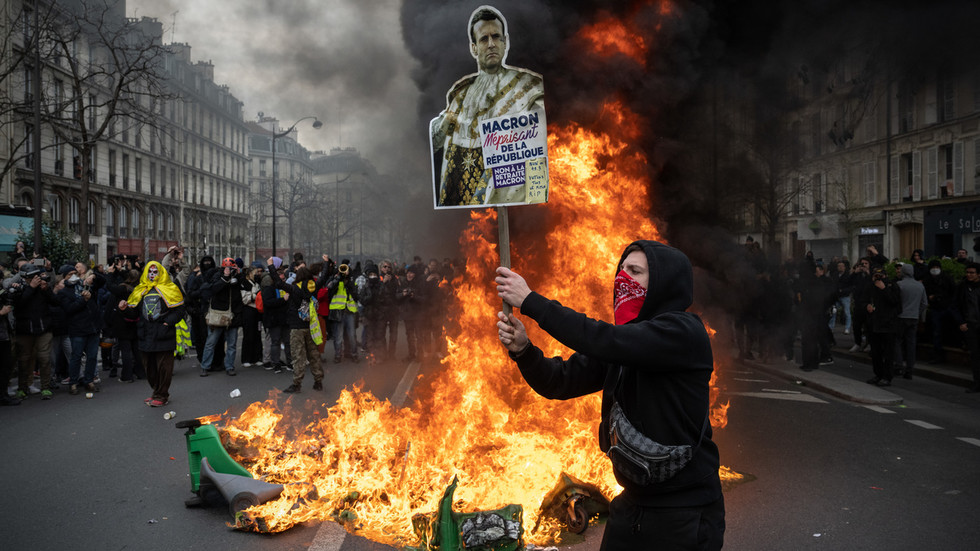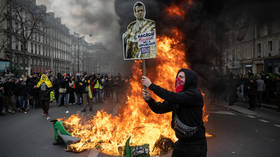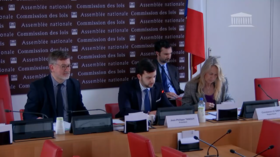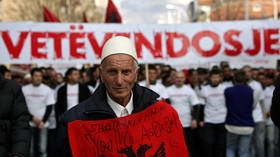
How the history, identities and aspirations of the various people of France mirror the structural identity and political integration of the EU
By Matthieu Buge, who has worked on Russia for the magazine l’Histoire, the Russian film magazine Séance, and as a columnist for Le Courrier de Russie. He is the author of the book Le Cauchemar russe (‘The Russian Nightmare’).

FILE PHOTO. A protester holds a placard next to fire during a rally against pension reforms on March 28, 2023 in Paris, France. © Carl Court/Getty Images
France is a medium-sized country with a wide range of accents, landscapes, and culinary traditions. In many ways, France, more than any other European country, is a symbol of the European Union. A crossroads for Celtic, Frankish, Iberian, and Latin populations, its foundations are not so much to be found in a cultural identity – they lay more in the administrative process that eventually led to the creation of the state.
A history of centralization of power
The history of France is a violent and slow one. The term ‘France’ did not appear officially until around 1190, when Philippe Auguste started to use the expression ‘Rex Franciae’ (King of France) instead of ‘Rex Francorum’ (King of the Franks). If it is possible to take this period as the time of the emergence of a national consciousness, one needs to remember that at the time, the country did not include Provence, Savoy, part of Burgundy, the Alsace-Lorraine, whereas all the west of France, from Normandy to the Pyrenees, was under the influence of the British House of the Plantagenets.
The French historian Barthelemy Pocquet du Haut-Jusse wrote in 1946: “Above all, let us not forget that France in the twelfth century was a monarchy only in appearance. Under the honorary presidency of a good-natured royalty, a robust confederation of large fiefdoms had been created in the tenth century, flourishing in the twelfth.” Maps indicate that in this period, the royal domain was limited to Paris and its southern region.

Read more
The French victory at the end of the Hundred Years’ War against England in the second half of the 15th century deprived the latter of its continental possessions and fostered the transformation of France from a feudal monarchy into a centralized state. However, the territorial completion of the country had to wait a few centuries. The war of religions considerably slowed the process and France had to wait for Louis XIV’s wars in order to see its expansion and modernization really resume. Alsace, Artois, and Franche-Comte were annexed between 1648 and 1697. The fiefdom of Lorraine remained an enclave until 1766. Corsica was bought in 1768. Provence remained de jure independent until the 1789 revolution. Savoy and Nice were not annexed until 1860. According to the estimations of historian Eric Hobsbawm, at the time of the French Revolution in 1789, only half of the population of France could speak French.
One can easily understand that the diversity was such within French territory that mistrust, even defiance, vis-a-vis the centralized power of Versailles or Paris, has been a constant in the history of France. The historian and demographer Emmanuel Todd, who has spent his life exploring issues related to family structures, has clearly demonstrated that their diversity and disparity have had a great influence on the French regions. Religious beliefs, industrial and agricultural dynamisms have evolved in different ways throughout the country. Todd shows that in 1791, Brittany, Flanders, Alsace, Franche-Comte, Occitania, and the Basque country all refused the Civil Constitution of the Clergy, a law passed in 1790 during the Revolution, which caused the immediate subordination of most of the Catholic Church to the government. These historical divergences of views between Paris and the provinces explain many of the troubles that shook (or are currently shaking) France. Hence the Wars of Religion (1562-1598), the Fronde (a series of civil wars from 1648 to 1653 triggered by the reinforcement of the monarchy), or the counter-revolutionary movement of the Chouannerie and the War in the Vendee after the 1789 revolution, which ended with the massacre of the Vendeans, to such a scale that many in France insist on the use of the term ‘genocide’. In 1800, Napoleon himself survived an assassination attempt organized by the Chouannerie. Conscription and the linguistic unification of the country were to become his tools in order to cement the French nation.

Read more
The extreme centralization of power was always primordial in France, a nation that could only rely on the state in order to maintain its cohesion. Tensions continue today. The movement of the Yellow Vests, which was above all a revolt of, as geographer Christophe Guilluy coined it, “peripheral France” against Paris.
France, in this regard, is an example for the EU, as it also has to deal with various cultures and aspirations, Spaniards and Poles having very little in common, Germans and Greeks having completely opposite economic models. During the Greek government debt crisis, many denounced the centralization of power and the unilateral decisions of the Troika (the European Commission, European Bank, and IMF). Poland has been a fierce opponent of the immigration quotas that Brussels seeks to implement. Hungary is opposed to the EU’s stance on the conflict between Russia and Ukraine. In order to have its recommendations endorsed by its members, the EU has to resort to imposing fines. Centralization of power was necessary to pacify France, and the goal that the EU assigned itself (to bring an end to wars in Europe) can’t be achieved through a wide delegation of power.
Separatist temptations
In 1992, the Council of Europe adopted the European Charter for Regional or Minority Languages to protect and promote historical regional and minority languages in Europe. France did not ratify it.
France’s territorial integrity does not seem to face any real threat, but separatist claims have always existed. The fact remains that 17 regions of metropolitan France alone have separatist movements. Some of them, such as the Basque country, even have five or six different separatist movements. Brexit has been an example for French nationalists who want to leave the EU, but for regional movements, Scotland and Catalonia are the inspirations.

Read more
However, their ideals and goals vary. In Franche-Comte, for example, activists do not seek full independence – because of its location, it would be an enclave, and therefore wants autonomy. In Savoy, independence aspirations did not have an electoral impact since the annexation in 1860, but in the 1990s, a movement for ‘disannexation’ appeared, that is to say, the acceptance by Paris of Savoy’s regionalism. The National Liberation Front of Provence, on the other hand, advocates for an independent state of Provence and secession from France. It appeared in 2012 and entered into a graffiti and bombing campaign. Most of the bombs failed to detonate and this clandestine movement seems somehow anecdotal, but the French government says it keeps a close eye on it.
But four of them seem more determined and are the most notorious. The 2015 departmental elections showed a progression of autonomist or separatist claims in Alsace, the Basque country, Corsica, and Brittany. In Alsace, two parties (Unser Land and Alsace d’abord) with opposite political sensibilities consider Alsace as a nation in itself and want autonomy from Paris. The Basque country is home to five parties that seek the unification and autonomy of the Basques from France and Spain. One of them, ‘Batasuna’ (Unity) was dissolved after it entered the EU’s official list of terrorist organizations because of its links with the armed Basque nationalist and far left separatist organization ETA (Euskadi Ta Askatasuna) which engaged in assassinations and bombings in Spain.
In Brittany, after a few decades of terrorist activities (the most famous episode being the 1978 bombing of the Palace of Versailles), the Breton Liberation Front ceased to exist, but its signature periodically re-emerges. However, activists in Brittany consider themselves to be a European ethnic minority and are more focused on decentralization from Paris and the protection of their linguistic heritage. In 1992, 1,774 students received their education in the local language; in 2014, it was 20,300. Still, Brittany can be a land of trouble for the government, as was seem in 2013 with the movement of the ‘Bonnets Rouges’ (red caps) against the Parisian decision to impose new taxes on truck transport.

Read more
Corsica’s stance is the most well known. The pride and violent determination of Corsicans is such that it has been the subject of jokes, books, movies, and the French government’s preoccupation for decades. ‘A bandera testa mora’, the most famous regional flag in France, seems to be in itself the symbol of a liberation front. In 1914, the political journal ‘A Cispra’ (the old rifle) stated: “Corsica is not a French department. It is a nation that has been conquered and will be reborn.” Activists try to achieve this goal either through political procedures or violent activities, which peaked with the infamous assassination of Prefect Claude Erignac in 1998.
One can easily understand that the EU policy in favor of regional cultural identities does not fit the traditional French national myth – just as national claims from EU member states do not fit the way Brussels and the European Commission understand the process known as ‘European integration’. Brussels has to go, while trying to avoid any conflict, the Parisian way.
Regional (and digital) identity
In an article in Le Figaro in 2017, one can read: “To tell the history of their regions, most of the nationalist movements contacted by Le Figaro converge towards the same date: August 25, 1539. This year, Francis the First signed the Ordinance of Villers-Cotteret, which adopted French as the kingdom’s official language.” Indeed, all these movements insist on the importance of their own language. Because, while it is true that regions want more political autonomy from Paris, the true motivation of activists lies in their perception of their identity. The importance of regional flags, which are frequently part of demonstrations all over France, is significant. The Corsican flag might be the most famous; people in Brittany have a sentimental relation to their ‘Gwenn ha du’ (perhaps because it has been banned in the past), just as the Basques take pride in their ‘ikurrina’, which is a symbol of both cultural unity and hope, as it is the official flag of the Spanish Basque Autonomous Community. Furthermore, in Brittany, several local currencies are in use (with exotic names such as ‘Galleco’, ‘Buzuk’, and ‘Bizh’). Though they are euro-backed, these symbolic initiatives show the wish of the regions to distance themselves from Paris.

Read more
Interestingly enough, in 2023, regional identity is also digital. Just as national domains such as .it (Italy), .de (Germany), and .fr (France) exist within the EU, regional domains have appeared in France. Unsurprisingly, this only includes the big four: Brittany (.bzh), Alsace (.alsace), Corsica (.corsica), and the Basque country (.eus).
The question of identity is something that Brussels also has to deal with in the European integration process. Many critics of the EU say it is lacking cultural integration. France’s example shows that language can be a double-edged sword. On the one hand, it indeed helped create national sentiment in France, but it also implies deep frustrations. Furthermore, the unofficial language of the EU (English) can’t satisfy most of its members, especially since the UK left the union in 2016.
However, the construction of France and European integration have much in common, and surveys show that their stabilities as political entities are quite similar. In 2019, an Ipsos poll showed that 59% of the French population had the feeling of belonging to a national community (61% of the rural population had the opposite feeling). In 2022, according to the European Parliament, 62% of the European population considered the fact that their country is part of the EU as positive. A big part of Europe still expresses distrust towards Brussels, just as a large part of the French population distrusts Paris. Both have the difficult task of managing identities. And the law passed by the French government in 2021 against separatism, which mainly targets ‘political Islam’, implies that the massive waves of migrants who arrived in Europe will only complicate the nation-building and union-building processes.




